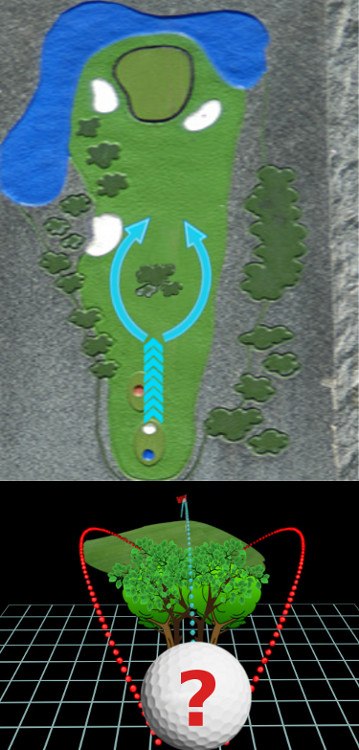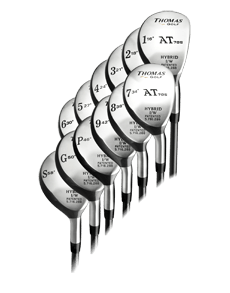It’s hard enough to hit one fairway, right? So what do you do when faced with two?

The “split fairway,” also called a “double” or “alternate” fairway, has been around for ages. Modern golf course architects are particularly fond of the concept, which makes the golfer weigh a number of factors in deciding which route to take.
A split fairway appears as a pair of fairways, one left and one right, divided by a hazard (i.e., a creek, a series of bunkers) or a strip of rough. The fairway that appears more difficult to hit from the tee is often the one which provides a preferable approach to the green.
In other words, you face a trade-off on the tee: Go for the easier fairway and take your chances with a tougher approach, or try the harder drive in exchange for a simpler second shot?
There may be several differences between the two fairways. One is likely wider, or less tightly guarded by hazards. The tougher fairway to reach probably serves up a shorter second shot and a better angle to the green, whereas an approach from the more open fairway might require clearing a bunker or water. Sometimes, one fairway is higher than the other and offers a better view of the next target.
Much like a center-line bunker, a split fairway forces the golfer to make a choice, then execute with confidence. Here are a few things to consider:
- Where does the biggest risk lie, and is the reward worth it? When picking a fairway, take stock of the entire hole, not just the tee shot. Let’s say hitting the right-side fairway demands a long carry across a lake and leaves you with a short, hazard-free pitch to the green. If you play left off the tee, you take the water out of play and leave yourself a slightly longer approach that must fly over a bunker.
- Therefore, the toughest and most potentially penal of all possible shots is a drive toward the right fairway, and the reward isn’t that much better than you’ll get from playing safely. The smart choice: left fairway.
- Which is the easiest fairway for you to hit? One fairway may look more forbidding than the other, but your favored shot shape may actually make it easier to hit. If playing up the wider right side demands a draw you don’t possess, the narrower left option may be a better bet if you can rely on your natural fade.
- Can you pull off the tougher drive? If there’s a forced carry required to reach the preferred fairway, can you clear the trouble with room to spare – say, 15-20 yards? If the preferred fairway is tighter, do you stand a decent chance of hitting it? Assess your accuracy on previous holes; if you’re below 50% for the day, take the wider path and give yourself a fighting chance. Are you drilling everything straight down the middle? Have a crack at the riskier side.
Architects create split fairways to encourage strategic thinking and plant doubt in the golfer’s mind. Be thorough in your thought process and confident in your decision, then take advantage of what the hole gives you.
Update:
A split fairway is a design feature found on some golf holes where the fairway splits into two or more separate landing areas. Golfers have the option to choose which side of the fairway to play from, each offering different advantages and challenges. Knowing how to play a split fairway strategically can lead to better positioning for the subsequent shot and potentially a more favorable approach to the green. Here's how to approach a split fairway:
- Evaluate the Layout: Before teeing off, carefully study the hole's layout and identify the split fairway options. Look for any hazards or bunkers that might come into play on either side of the fairway. Consider the distance to the landing areas and how it aligns with your preferred shot shape.
- Assess Your Game: Assess your own strengths and weaknesses as a golfer. If you consistently hit a fade or slice, you might prefer the side of the fairway that caters to that shot shape. On the other hand, if you have a reliable draw, you may want to play to the opposite side.
- Choose the Right Club: Depending on the distance to each landing area, select the appropriate club that gives you the best chance of reaching your preferred side of the fairway. Distance and accuracy are essential factors to consider.
- Factor in Wind and Conditions: Take into account any prevailing wind direction and speed. The wind can influence the trajectory and carry of your tee shot, so aim accordingly.
- Play to Your Comfort Zone: If you have a more comfortable approach shot from one side of the fairway, choose that option even if it means sacrificing a bit of distance off the tee. A well-placed tee shot can set you up for a more straightforward approach to the green.
- Consider the Pin Placement: Take note of the pin placement on the green. If the pin is tucked to one side, it may be advantageous to favor that side of the fairway, as it allows for a better angle into the green.
- Avoid Trouble: Be mindful of any hazards or trouble areas near the landing areas. If one side presents a higher risk of getting into trouble, it might be best to play to the safer side.
- Stay Confident: Once you've made your decision, commit to your chosen side and execute your shot confidently. Second-guessing your choice mid-swing can lead to a less-than-desirable result.
Remember that split fairways add a strategic element to the game and offer an opportunity for players to showcase their decision-making skills. It's essential to adapt your approach based on the specific layout and conditions of each hole. By understanding the advantages and challenges of each side of the fairway and playing to your strengths, you can position yourself for a successful round of golf.
What is a Split Fairway, and How Do You Play It?
Split Fairway Definition: A split fairway refers to a golf hole where the fairway is divided into two separate sections, usually by a hazard or strategically placed bunkers. Golfers have the option to choose which side of the fairway to aim for based on their playing style, strengths, and the overall layout of the hole.
How to Play a Split Fairway:
- Assess Your Strengths:
- Consider your strengths and weaknesses. If you have a preferred shot shape or distance control with a particular club, factor that into your decision.
- Evaluate the Layout:
- Analyze the hazards, bunkers, or obstacles that divide the fairway. Determine which side provides a more favorable angle for your approach shot to the green.
- Consider Wind Conditions:
- Take into account the direction and strength of the wind. Choose the side that aligns with the wind conditions to maximize control over your shots.
- Think About Pin Placement:
- Anticipate the location of the pin on the green. One side of the fairway may offer a more direct line to the pin or a better angle to approach certain pin positions.
- Factor in Course Conditions:
- Assess the overall course conditions, including the firmness of the fairway and potential roll. This can influence the distance your ball travels after landing.
- Choose the Safer Side:
- If one side of the fairway has fewer hazards or offers a larger landing area, consider choosing the safer option to increase the likelihood of hitting the fairway.
- Select a Comfortable Club:
- Choose a club that you are comfortable and confident using. It could be a driver for a longer shot or a fairway wood for more accuracy. Tailor your club selection to the specific requirements of each side.
- Execute with Confidence:
- Commit to your decision and execute the shot with confidence. A well-struck shot that finds the chosen side of the fairway sets up a better approach to the green.
- Be Mindful of Strategy:
- Think strategically about the entire hole, not just the tee shot. Consider how your choice on the split fairway sets up the rest of the hole, including potential challenges on the approach.
- Practice Decision-Making:
- During practice rounds, intentionally play split fairways to hone your decision-making skills. Evaluate the outcomes and learn from each experience.
Q&A On What is a Split Fairway, and How Do You Play It?
- Q: Are split fairways common on most golf courses?
- A: Split fairways are found on some courses, typically on holes designed to offer strategic choices. They are not universally common but can add variety to course layouts.
- Q: Should I always aim for the wider side of a split fairway?
- A: Not necessarily. Assess the entire layout, including hazards, pin position, and your preferred shot shape. Sometimes the narrower side may provide a better approach angle.
- Q: What's the advantage of hitting the fairway's narrower side?
- A: The narrower side might offer a more direct line to the green, avoiding potential hazards or providing a better angle to certain pin positions.
- Q: How do I factor in potential roll when choosing a side on a split fairway?
- A: Consider the firmness of the fairway and the potential roll after landing. If the fairway is firm, factor in extra yardage for roll when selecting a side.
- Q: Should I always go for the split fairway, or are there situations where it's better to play it safe?
- A: It depends on your skill level and the specific hole. If you are comfortable with the split fairway and it aligns with your strengths, it can be a strategic choice. However, playing it safe may be prudent in certain situations.
- Q: How do course architects use split fairways to challenge golfers?
- A: Course architects use split fairways to introduce strategic decision-making. They create opportunities for risk and reward, forcing golfers to think about their strengths and the layout of the hole.
- Q: Can split fairways impact your strategy for club selection on the tee shot?
- A: Absolutely. The choice of split fairway can influence your club selection. A wider side may allow for a driver, while a narrower side may call for a more accurate fairway wood or hybrid.
- Q: Should I always consider the wind when choosing a side on a split fairway?
- A: Yes, wind conditions can significantly impact your shot. Factor in the wind's direction and strength when deciding which side of the split fairway to aim for.
- Q: Can split fairways be found on par-3 holes?
- A: Split fairways are more common on par-4 and par-5 holes where strategic decision-making is emphasized. Par-3 holes typically have a direct route to the green without split fairways.
- Q: How can I practice playing split fairways during a round?
- A: During practice rounds, intentionally choose different sides of the split fairway to simulate real-game decision-making. Evaluate the outcomes and learn from each experience.





